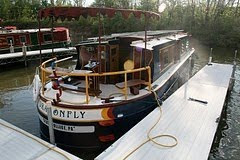 |
| The limestone bluffs fringing the water add interest to the scenery. |
Some of these ferries are operated by the Illinois Department of Transportation, and you can ride them at no charge, 24 hours a day, 7 days a week. It's just part of the state transportation system
Early one morning outside of Grafton we passed this ferry, giving kids an unconventional ride to school.
In Alton, Illinois, we got off the boat and onto our bikes. An amazing bike path, The Confluence Bikeway, runs for miles here, along the top of the river levee.
We pedaled to the "National Great Rivers Museum," a surprising little gem of a museum operated by the U.S. Army Corps of Engineers at the Melvin Price Lock and Dam (which is one of the newer locks the Corps has built on the Mississippi River).
The exhibits cover every aspect of the river: hydrology, geology, biology, sociology, have I forgotten any -ologies? We especially liked the water table, where a miniature river is actively cutting through a layer of mud, showing you how such river features as oxbows, braided channels and deltas are formed.
 |
| An entertaining model of this section of the Mississipi decorates the museum plaza.The Captain's floating sandals are canalboats, having a race. |
There's also a towboat simulator, so you can see what it feels like to pilot one of those massive, 1000-foot-long barges.
And (with the Grafton ferryboat on my mind) I was fascinated by the historic picture of a mule-powered ferry on the Illinois River. Of course we knew that on the Erie Canal, mules TOWED canal boats, but on the kind of ferry I am talking about, horses or mules were actually aboard the boat, working more like hamsters on a giant hamster wheel to propel the craft. (Click the link to see the picture, which is worth the proverbial thousand words).
Besides the museum proper, we also took a tour of the lock, which we would be passing through the next day. We took an elevator four flights up to a walkway over the lock.
We knew Dragonfly would be going through the "auxiliary" lock, the one for "small" vessels. (It's a mere 600 feet long.) The main lock is 1,200 feet long, and while we watched, the 15-barge tow at right was locking through. (Click the link to watch a video on U-tube of a big tow, under way.)
I keep kidding the Captain that with all his experience piloting a big barge, after this trip he can get a job as a towboat captain. He'd be out on the water all day, enjoying the scenery, applying his skills at cozying up to lock walls . . . .
But if that doesn't appeal, maybe he'll be marketing solar canalboat ferries--maybe as a sustainable alternative to those gas-powered water taxies back in Chicago. In researching the mule-powered ferry, I learned that the first electric-powered boat was invented in Russia in 1838--contemporaneous with the early days of the Erie Canal. And a few years after the first trolley was invented, a man named Frank Hawley adapted the technology to power a canal boat. (It made a test run, tethered to overhead electrical wires, on the Erie in 1893).
Electric boats were actually pretty common in Europe for a brief while . . . before (ironically) the invention of the electric starter motor helped internal combustion engines to become the technology of choice. Who knew?
Today a number of companies in Europe are back at it, designing and marketing--or operating small fleets of--electric boats. So perhaps the time is ripe for America to embrace SlowBoatin'.
 |
| Speaking of slow . . . a moment in the life of a towboat deckhand |







Fascinating info. Great blog. So much to absorb and learn. Great pictures!! We love it all.
ReplyDeleteThanks, glad you like!
ReplyDelete